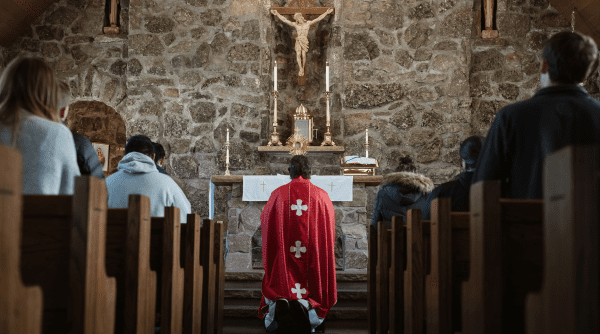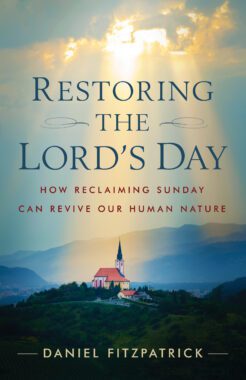Remember the sabbath day—keep it holy. Six days you may labor and do all your work, but the seventh day is a sabbath of the Lord your God. You shall not do any work, either you, your son or your daughter, your male or female slave, your work animal, or the resident alien within your gates. For in six days the Lord made the heavens and the earth, the sea and all that is in them; but on the seventh day he rested. That is why the Lord has blessed the sabbath day and made it holy. (Exod. 20:8–11)
The third commandment brings together creation and Israel’s redemption. No longer will the people work simply for the fulfillment of Pharaoh’s desires, laboring to create garrisons and monuments for future wars and future remembrances of the kings of the past. Rather, they will dedicate themselves to God, resting every seventh day in imitation of the God who gazes upon the goodness of His creation. Every seventh day, the people will allow themselves to be made new through this contemplative imitation—which is also worship.
The pattern of creation and redemption continues when Moses goes up the mountain to receive the tablets on which God Himself has written the Commandments: “Moses went up the mountain. Then the cloud covered the mountain. The glory of the Lord settled upon Mount Sinai. The cloud covered it for six days, and on the seventh day he called to Moses from the midst of the cloud” (Exod. 24:15–16). Here the seventh day becomes the moment of communion between God and man. It is the moment when man, resting in the presence of the Lord, reorients himself properly to learn how to act and worship in accord with God’s being. On the mountain, Moses receives not only the Ten Commandments, which detail the moral lineaments of Israel’s life, but also the plan for the tabernacle, including the Ark, the table, the menorah, and the tent cloth. This tabernacle would become a sanctuary for the Lord, that He might dwell in the midst of the people (Exod. 25:8). The connection between the tabernacle as the dwelling of the Lord and the Sabbath as the center of worship is emphasized by the reiteration of the Sabbath command at the end of God’s colloquy with Moses, immediately after the details for the construction of the tabernacle:
The Lord said to Moses: You must also tell the Israelites: Keep my sabbaths, for that is to be the sign between you and me throughout the generations, to show that it is I, the Lord, who make you holy. Therefore, you must keep the sabbath for it is holiness for you. Whoever desecrates it shall be put to death. If anyone does work on that day, that person must be cut off from the people. Six days there are for doing work, but the seventh day is the sabbath of complete rest, holy to the Lord. Anyone who does work on the sabbath day shall be put to death. So shall the Israelites observe the sabbath, keeping it throughout their generations as an everlasting covenant. Between me and the Israelites it is to be an everlasting sign; for in six days the Lord made the heavens and the earth, but on the seventh day he rested at his ease. (Exod. 31:12–17)
The Sabbath injunction thus frames the covenant at Sinai. It marks the beginning of Israel’s dependence on God in the collection of the manna. It rests at the heart of the Ten Commandments. And it orders all of the moral and liturgical activity enjoined on Israel through Moses on the mountain. The creative pattern that God established in the beginning is to be the embodied cultural sign whereby Israel will show itself to be set apart by God, made holy by Him and utterly dependent on Him for its existence. Thus, Israel shall be for all the world a beacon of God’s creative activity, activity which never ceases and which is fulfilled in the redemptive labors of the Word.
In the New Covenant, Christians no longer observe the seventh-day Sabbath of the Jews. Rather, in honor of Christ’s Resurrection, we celebrate the Lord’s Day on the first day of the week. Nonetheless, Christian observance of the Lord’s Day subsumes and elevates the Jewish Sabbath and in so doing fulfills the commandment to keep holy the Sabbath day, which is not abnegated by the New Covenant. And, if we are to honor the Sabbath, we would do well to attend closely to Jesus’ Sabbath practices.
Among all His actions, these are some of the most bitterly contested by the scribes and Pharisees. He persists in healing on the Sabbath, in letting his disciples pick heads of grain, perhaps at times in traveling beyond the traditional Sabbath day’s journey allowed by the law. Especially in an age like ours, when the thought of abstaining from anything at all on the Sabbath feels so alien, the Pharisees’ objections to Jesus’ Sabbath works can seem bewildering, if not laughable, a feeling which can easily extend to the practices still current among some Orthodox Jews.
Perhaps our reaction might abate in some measure when we remember the importance of the Sabbath ordinances delivered in Exodus. The Sabbath was to be the principal sign by which Israel showed itself marked by God, subject to Him rather than to a king. Adherence to the law was the means by which Israel could remain under God’s wing. If picking heads of grain on the Sabbath seems a minuscule matter to us, we might recall that Israel was not allowed to collect manna on the Sabbath. If adherence to the law seems to us an irrelevant obsession, we might remember that failure to observe the law had led again and again to Israel’s defeat in battle, to destruction of the Temple, to new imprisonment. And the shadow of the new pharaoh in Rome loomed large over Israel in Jesus’ day.
Nonetheless, Christ leads Israel to a renewed understanding of Sabbath holiness as a participation in the ongoing creative fullness of God’s contemplative life. One Gospel text in particular may serve as programmatic for Jesus’ Sabbath labor and our imitation thereof. John 5 begins with the deeply moving narrative of Christ’s healing the paralytic at the pool of Bethesda. The man had suffered thirty-eight years with his affliction, and there was no one to move him into the pool when it was agitated by the presence of the Spirit. In this pool, we might find an image of the void over which the Spirit broods in Genesis 1, with the crowds of sick at its side like so many signs of fallen creation, groaning toward renewal after the fashion St. Paul describes in his Letter to the Romans. Christ heals the paralytic and sends him on his way. The healed man is accosted by the Pharisees, who remind him that it is unlawful to carry his mat on the Sabbath. He can only respond, ignorant of Christ’s identity, that the man who healed him told him to take up his mat and walk. Once the Pharisees learn that it was Jesus who healed him, they confront him: “Therefore, the Jews began to persecute Jesus because he did this on a sabbath. But Jesus answered them, ‘My Father is at work until now, so I am at work.’ For this reason the Jews tried all the more to kill him, because he not only broke the sabbath but he also called God his own father, making himself equal to God” (John 5:16–18).
It is Jesus’ response, “My Father is at work until now, so I am at work,” that so profoundly reveals the difference between the stultified vision of Sabbath rest which had arisen in Israel and the fullness of that rest as participation in the divine life to which God has called us from the beginning. The work of Creation, as noted above, does not simply stop on the seventh day. For one thing, as Snell notes, the text of Genesis indicates that “On the seventh day God completed the work he had been doing.”100 The seventh day marks the moment when God brings His work to completion and then rests in contemplation of Himself. Because God is the cause of His work, in contemplating Himself He is also contemplating the work, whose being He constantly maintains. The rest of the seventh day is thus the rest of the enduring ordinance of reality.
Christ’s Sabbath labors, then, constitute an ongoing participation in that work of ordering reality. Where there is formlessness, as in an eye stricken with blindness, He, the eternal Word, through which the Father spoke creation into being, brings form. Where there is imperfection, as with a paralytic, He brings perfection. Where there is the lack of being which we call evil, He brings goodness, renewing the things of the world in accord with the goodness that the Father eternally observes and brings about.
The idea that Christ’s ministry, including His Sabbath healings, should continue the labor of the Father, who of course does not exist in time but in the eternal now of which Sabbath rest is a foretaste, is reinforced by the way John introduces Christ’s public ministry at the wedding at Cana. We are told that this wedding is held on the third day, the day of epiphany, the day on which God descended upon Sinai and the day on which Christ would rise from the dead. Moreover, the wedding may be taken as symbolic of the sixth day of the Creation account, when man and woman were made. By beginning His public ministry at a wedding, at the pinnacle, as it were, of creation, Christ signals that He is continuing the creative labor of His Father. This work has not yet been perfected at the time of Cana, though. The six stone water jars whose contents Christ would turn to the richest wine signify that the abundance of life (the fullness represented by the number seven) has not yet been bestowed on man. That would come at the wedding which concludes Christ’s Passion, His marriage to the Church.
The Sabbath is mentioned infrequently, though with immense significance, throughout the rest of John’s Gospel. In John 7:21–22, Christ, interrogated by the Jewish leaders, refers to His healing of the paralytic as the reason for their discontent with Him. Master of the law that Christ is, though, He in turn questions the Pharisees on their own Sabbath practices, reminding them that they themselves will circumcise a child on the Sabbath should the appointed day coincide with the Sabbath feast. In John 9, Christ heals another man on the Sabbath, making a paste of saliva and clay to smear on the man’s eye and restore his sight. Again, the narrative is pregnant with memories of Genesis, with the creation of man out of clay and the emergence of new life from the watery chaos of the pool of Siloam. In John 12:1, Christ comes to Bethany for His last visit with His friends prior to His Passion. We are told that this takes place six days before Passover, and, if Passover fell on a Friday, that would place the visit to Bethany, as Scott Hahn notes, on the Sabbath.101 If so, this would make that least meal at Bethany particularly important for interpreting a Christian way of honoring the Sabbath, as it is the last Sabbath to take place before the transformation of the Sabbath through Christ’s death and Resurrection. We will return to this passage in a later chapter, when we consider the importance of family and friends in celebration of the Lord’s Day. Finally, there is the dreadful Sabbath of Christ’s entombment and descent into the realm of the dead, followed by the transformation of the first day of the week through His Resurrection. On that day, Christ appears first to Mary Magdalene and then to the apostles. A week later, He appears once again, this time when Thomas is present.
We will treat the Lord’s Day shortly, but for now let it suffice to say that Christ’s labor, which encompasses the Sabbath as a demonstration of God’s ongoing work of causing the universe to be, gives way to the timelessness of the resurrected Lord, who invites us, as it were, into the eighth day—that reality in which space and time are drawn up eternally and glorified into the presence of the Lord.
The other Gospels give plentiful examples of the kind of work Christ does on the Sabbath, that work of restoring nature to its original order and preparing it for glorification in the resurrection.
Mark’s Gospel almost immediately shows Jesus in the midst of Sabbath labor. After Christ has been baptized, gone into the wilderness, and called the first apostles, He comes to Capernaum, where He enters the synagogue on the Sabbath and teaches. The rest of the chapter unfolds so quickly that it is easy to lose sight of the fact that Jesus does an enormous amount of work on this single Sabbath. He cures a man with an unclean spirit. He then heals Simon’s mother-in-law (who, we should recognize, immediately gets up and waits upon the Master, providing a rich model in her own right for Sabbath labor). Evening comes and He heals all the sick and possessed brought to Him from the whole town, which has gathered at the door. Mark 1 thus supplies us with a beautiful portrait of the transition from Old Testament Sabbath worship to the kind of Sabbath worship enjoined on Christians. Whereas Christ goes into the synagogue with the rest of Israel, His labor of restoring Israel to freedom and health then calls all the people to come to Him. He becomes the new temple, in whose person worship and thus all of creation is summoned to a higher pitch of being.
In Mark 2, we witness the disciples picking heads of grain on the Sabbath, and we hear Jesus’ reply to the Pharisees, reminding them that David himself consumed the showbread in his hour of need. It is here that He declares that “the sabbath was made for man, not man for the sabbath. That is why the Son of Man is lord even of the sabbath” (27–28). And in Mark 3:5, having once again entered the synagogue on the Sabbath, Christ heals a man with a withered hand, saying “Stretch out your hand.” There is an echo here of God’s words to Moses, suggesting that in healing and restoring order on the Sabbath, Christ is likewise making us fit to carry out the prophetic and priestly work to which God has called us as fellow laborers in the vineyard. Finally, we find in Mark 6 the account of Jesus’ rejection at Nazareth, when He enters the synagogue and reads from Isaiah, only to be rejected by the people, unable to work many miracles on account of their lack of faith.
+
This article on The Insular City is adapted from the book Restoring the Lord’s Day by Daniel Fitzpatrick which is available from Sophia Institute Press.
Art for this post on a reflection from “Restoring the Lord’s Day” by Daniel Fitzpatrick: cover used with permission; Photo by Josh Applegate on Unsplash






